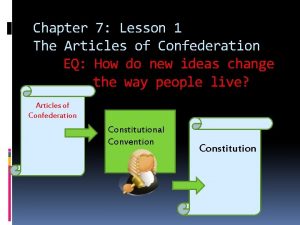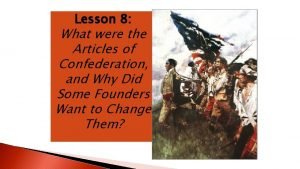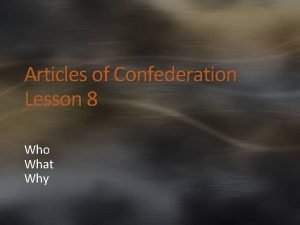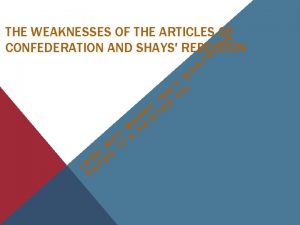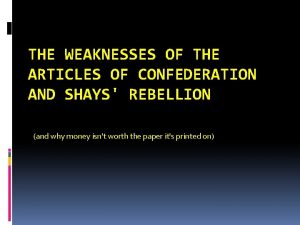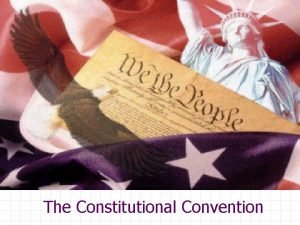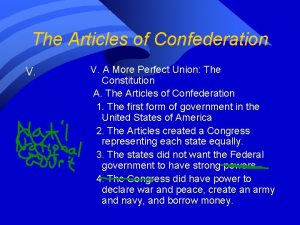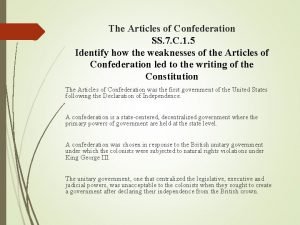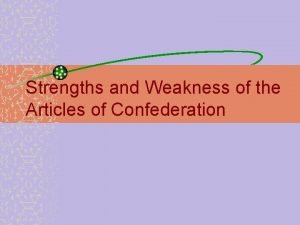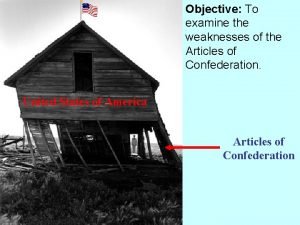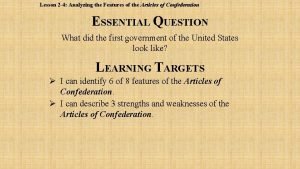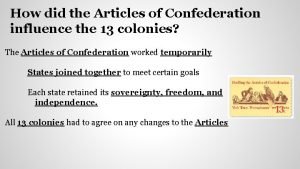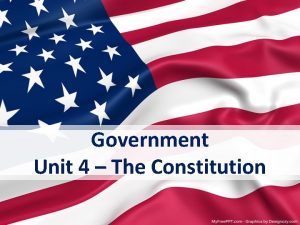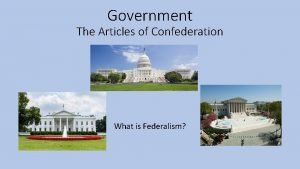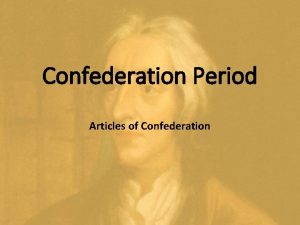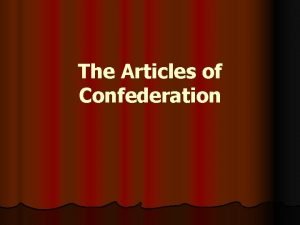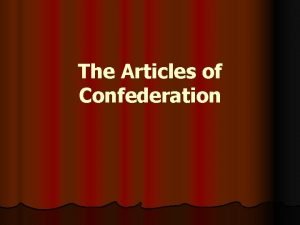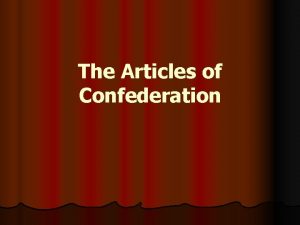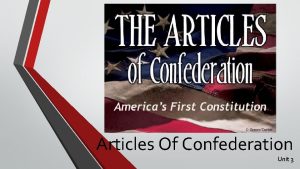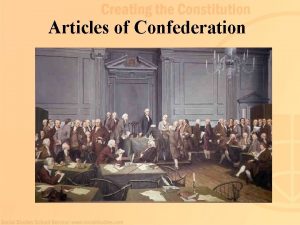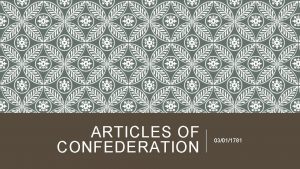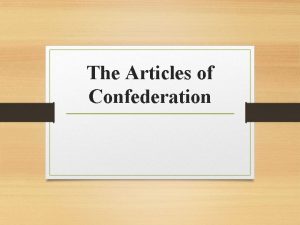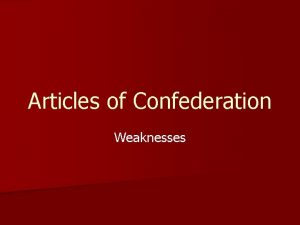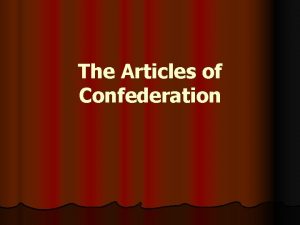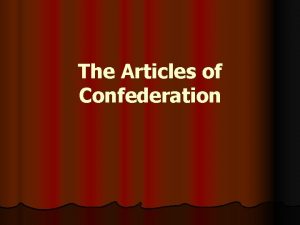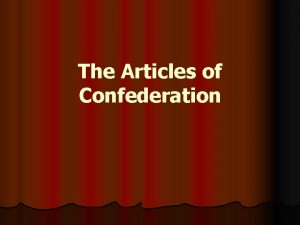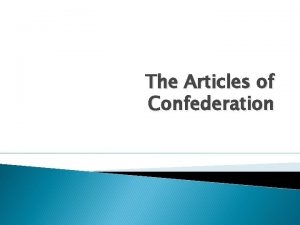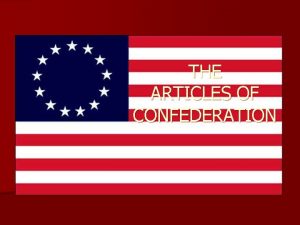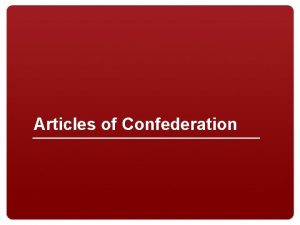Chapter 7 Lesson 1 The Articles of Confederation
















- Slides: 16

Chapter 7: Lesson 1 The Articles of Confederation EQ: How do new ideas change the way people live? Articles of Confederation Constitutional Convention Constitution

Ch. 7, Lesson 1 Vocabulary (pg. 182) Bicameral Republic Ordinance Ratified

Timeline: Articles of Confederation to Constitution (1781 -1789) 1781 1783 1786 – 1787 -1789 Articles of Confederation ratified by all 13 states British surrender at Yorktown Treaty of Paris 1783 ends the Revolutionary War Shay’s Rebellion in Massachusetts Constitutional Convention held in Philadelphia US Constitution ratified George Washington becomes the first President

Confederation Congress During the War the USA was governed by a group of men called the Confederation Congress. They— 1. Negotiated the Treaty of Paris 1783 2. Created the Articles of Confederation 3. Passed the Northwest Ordinance of 1787

The Treaty of Paris (1783) Was the Treaty of Paris of 1783 a fair deal to the USA? Why or why not?

How would each state be governed? Confederation Congress created a republic A gov. in which we elected officials States adopted a constitution (plan of gov. ) Most states set up two-house (bicameral) bicameral legislatures (congress)

The Articles of Confederation (1781 -1789) During the War, the original 13 states ratified (agreed to) a document called: The Articles of Confederation. - It created a federal government in the USA.

The Articles of Confederation Read The Articles of Confederation, (pg. 184) identify the following: Powers Given to Congress in the Articles of Confederation Powers NOT GIVEN to the Congress in the Articles of Confederation 1. 2. 3. 4. 1. 2. 3. Read the Confederation Government (pg. 185) 1. Why was the Congress (Confederation Gov. ) weak? 2. How many votes were required to change the Articles of Confederation?

Primary Source Analysis Answer the following in complete sentences: 1. What widely recognized symbol is being used? 2. Look at the details, what is the cartoon trying to tell us? 3. Who is the audience the cartoon is trying to reach?

The Articles of Confederation Powers Given to Congress in the Articles of Confederation 1. Conduct Foreign Affairs 2. Maintain armed force 3. Borrow money 4. Issue currency (money) Powers NOT GIVEN to the Congress in the Articles of Confederation 1. Regulate (control) trade 2. Force citizens to join the army 3. Impose (collect) taxes Read the Confederation Government (pg. 185) 1. Why was the Congress (Confederation Gov. ) weak? States kept most of their power. Congress could not vote on law unless 9 states approved it. No chief executive (President) to carry out the laws. 2. How many votes were required to change the Articles of Confederation? The approval of all 13 states.

Activity: Shay's Rebellion Read pg. 190 -191. Answer the following in complete sentences. 1. Summarize Shay’s Rebellion in your own words in one paragraph 2. What problems did the government faced under the articles of confederation? 3. Why did farmers in Massachusetts rebel in 1787?

Weakness of the Articles of Confederation led to Problems After the War: The Confederation Congress couldn’t collect taxes, they had no way of getting money to pay soldiers that had fought in the war. Led to rebellions and violence. Ex) Shay’s Rebellion

The Northwest Territory Confederation Congress set up ordinances (laws) on how to settle and divide the Midwest lands.

Northwest Ordinance 1787 Explained how the NW Territory was to be governed. It set a pattern for the orderly growth of the United States.

Activity: Northwest Ordinance 1787 Turn to pg. 186 -187 Complete the following worksheet independently.

Northwest Territory Rights guaranteed to the NW Territory settlers: Requirements for Statehood: Slavery was outlawed When a territory had at least 60, 000 people, they could apply to become a new state Freedom of religion Trial by Jury Each state treated equally to the original 13 states
 Chapter 7 lesson 1
Chapter 7 lesson 1 Achievements of the articles of confederation
Achievements of the articles of confederation Lesson 8 the articles of confederation
Lesson 8 the articles of confederation Political weaknesses of the articles of confederation
Political weaknesses of the articles of confederation Achievements of the articles of confederation
Achievements of the articles of confederation Problems with the articles of confederation
Problems with the articles of confederation Articles of confederation strengths
Articles of confederation strengths Weaknesses of articles of confederation
Weaknesses of articles of confederation Strengths of the articles of confederation
Strengths of the articles of confederation Articles of confederation weaknesses
Articles of confederation weaknesses Strengths of articles of confederation
Strengths of articles of confederation Articles of confederation strengths and weaknesses
Articles of confederation strengths and weaknesses Failures of the articles of confederation
Failures of the articles of confederation Strengths of the articles of confederation
Strengths of the articles of confederation Grading the articles of confederation
Grading the articles of confederation Articles of confederation vs constitution
Articles of confederation vs constitution Articles of confederation fail
Articles of confederation fail
